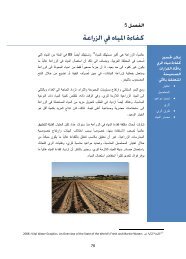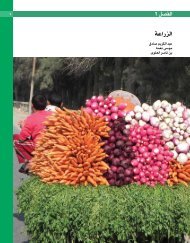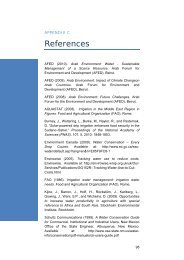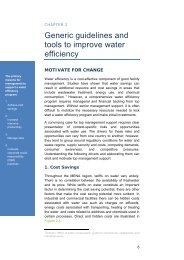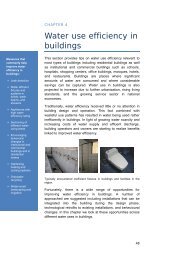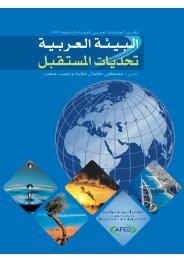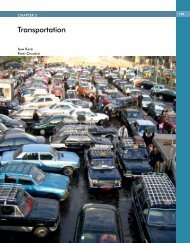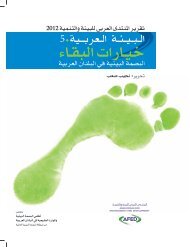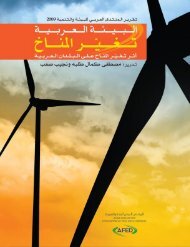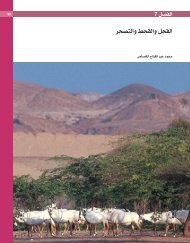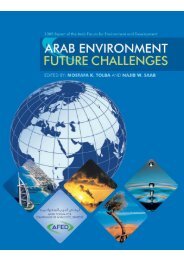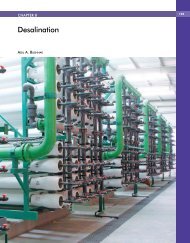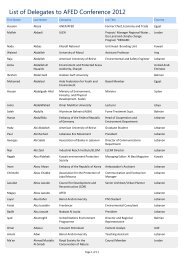Impact of Climate Change on Arab Countries - (IPCC) - Working ...
Impact of Climate Change on Arab Countries - (IPCC) - Working ...
Impact of Climate Change on Arab Countries - (IPCC) - Working ...
You also want an ePaper? Increase the reach of your titles
YUMPU automatically turns print PDFs into web optimized ePapers that Google loves.
ARAB ENVIRONMENT: CLIMATE CHANGE 77<br />
• Nile Basin countries: Egypt and Sudan.<br />
• <strong>Arab</strong>ian Peninsula: Saudi <strong>Arab</strong>ia, Kuwait,<br />
United <strong>Arab</strong> Emirates, Qatar, Oman, Bahrain<br />
and Yemen.<br />
• Sahel countries: Somalia, Djipouti and<br />
Comoros Islands.<br />
Each <str<strong>on</strong>g>of</str<strong>on</strong>g> the above five regi<strong>on</strong>s has its distinct<br />
hydrological characteristics that can briefly be<br />
explained as follows:<br />
Al Mashrek Regi<strong>on</strong><br />
• Iraq and Syria are partially dependant <strong>on</strong> the<br />
Tigris and Euphrates rivers, originating from<br />
Turkey. The two countries have rainfall <str<strong>on</strong>g>of</str<strong>on</strong>g> reas<strong>on</strong>able<br />
intensity and groundwater potential in<br />
both countries is relatively high. Syria enjoys<br />
small flows caused by snow melt from the<br />
peaks <str<strong>on</strong>g>of</str<strong>on</strong>g> some local mountains.<br />
• Leban<strong>on</strong> depends <strong>on</strong> a number <str<strong>on</strong>g>of</str<strong>on</strong>g> local rivers<br />
or rivers shared with <strong>on</strong>e or more <str<strong>on</strong>g>of</str<strong>on</strong>g> the neighbouring<br />
countries.<br />
• The per capita shares <str<strong>on</strong>g>of</str<strong>on</strong>g> water in Leban<strong>on</strong> as<br />
well as in Syria and Iraq are the highest am<strong>on</strong>g<br />
all <strong>Arab</strong> countries.<br />
• Jordan and Palestine are the water poorest in<br />
this regi<strong>on</strong> since they depend up<strong>on</strong> the Jordan<br />
river and small quantities <str<strong>on</strong>g>of</str<strong>on</strong>g> rainfall and<br />
groundwater.<br />
Al Maghreb Regi<strong>on</strong><br />
• All five Maghreb countries depend mainly <strong>on</strong><br />
rainfall and partially <strong>on</strong> modest groundwater<br />
reserves.<br />
Nile Basin Regi<strong>on</strong><br />
• The southern part <str<strong>on</strong>g>of</str<strong>on</strong>g> Sudan enjoys ample precipitati<strong>on</strong><br />
which can meet the prevailing evaporative<br />
demand; however, rain gradually vanishes<br />
north <str<strong>on</strong>g>of</str<strong>on</strong>g> the capital Khartoum. Following<br />
the signing <str<strong>on</strong>g>of</str<strong>on</strong>g> the Nile Water Agreement in<br />
1959, Sudan and Egypt divided the average<br />
natural flow at Aswan (84 billi<strong>on</strong> m 3 /year) to<br />
<strong>on</strong>e quarter for Sudan (18.5 billi<strong>on</strong> m 3 /year),<br />
three quarters for Egypt (55.5 billi<strong>on</strong> m 3 /year)<br />
and the remaining 10 billi<strong>on</strong> m 3 /year were left<br />
to make up for natural evaporati<strong>on</strong> from Lake<br />
Nasser.



